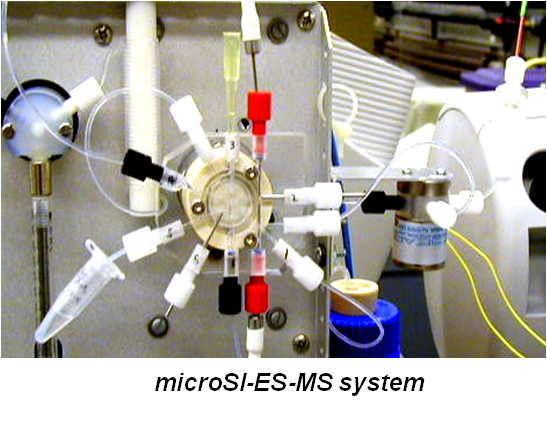Use of FI as a “front end” to MS automates solution handling tasks, improves detection limits, shields samples from external contamination, improves reproducibility of standard additions and facilitates matrix removal and analyte accumulation when needed. Yet, except for ICP-MS, other external ionization sources are compatible with much lower flow rates than FI, so there is an opportunity to extend these advantages to a wider MS field by using microSI-LOV as a platform for sample processing.
Mass Spectrometry
2.4.12.

Simultaneous multielemental analysis in FI-ICP-MS format has a wide range of applications due to its convenience, versatility and effectiveness in removing sample matrix components (Gine 2008). Since the sample inlet to MS tends to clog, samples with high salt content (e.g., sea water or mineral digest) cannot be directly aspirated. Injection of a small sample volume, sandwiched between wash solutions, alleviates this problem. Isotope dilution is facilitated by automatically spiking the samples within the FI system. Kinetics of hydride generation are precisely controlled by FI, and the use of sorbent extraction for matrix removal offers the same advantages as for AAS.
Thermospray MS coupled to tandem QMS/MS was for the first time hyphenated by FI (Geerding 1996) and used to analyze triazine herbicides and their degradation products in water.
Electrospray FI-ESI-MS/MS was developed later, by using isotopically-labeled internal standards of thiabendazile 13C for the quantification of fungicides (Ito 2003). The method replaced more tedious and time consuming LC and GC assays. Since then many FI-ES-MS protocols have been developed, as summarized in a thorough review of FI-MS (Gine Table 19.3). There is without doubt much more to happen in this field, when the potential of the microSI-LOV becomes more widely recognized.
M. F. Gine “Flow Injection Mass Spectrometry”. Ch19 in “Advances in Flow Analysis. M. Trojanowicz Ed. Wiley 2008.
Geerding R.B, Berg P.J.Kienhauis P.G.M., Brinkmann U.A.T. Int. J. of Env. and Analytical. Chem. 64, 265. 1996.
Ito Y., Goto T., Oka H.,Matsumoto H. MiyasakiY, Takahashi N., Nakazawa H. J. Agri. and Food. Chem. 51, 861 2003.









